Hello Rich, watched and learned a lot. An admirable job, respect.Rigging of brailed sails is a look back into the Bronze Ages when most of the known/assumed information is from old pottery shards and other iconographic sources from those ages. My present understanding is that with the evolution of the lanteen sail it was no longer used but that may not include squarely bent sails; however as far as I know there was no usage of brail lines as such in the following epochs. It would be more interesting to set the sail and lines for quartering or crosswind sailing but that would not be consistent with the presentation need of this model which actually could have been fully furled and in port.
One caution though was that I should have made a new glue mix for the hanks as what I used was left over from by BN and too concentrated from evaporation. I'll just call the coated lines as sea salt exposure from heavy usage.Rich
-

Win a Free Custom Engraved Brass Coin!!!
As a way to introduce our brass coins to the community, we will raffle off a free coin during the month of August. Follow link ABOVE for instructions for entering.
-

PRE-ORDER SHIPS IN SCALE TODAY!
The beloved Ships in Scale Magazine is back and charting a new course for 2026!
Discover new skills, new techniques, and new inspirations in every issue.
NOTE THAT OUR FIRST ISSUE WILL BE JAN/FEB 2026
You are using an out of date browser. It may not display this or other websites correctly.
You should upgrade or use an alternative browser.
You should upgrade or use an alternative browser.
Kyrenia Ship, 290 BCE Reconstruction POF Build Log PT-2 [COMPLETED BUILD]
- Thread starter PT-2
- Start date
- Watchers 23
-
- Tags
- completed build
Thank you Mash, I have also learned a lot as I proceeded and will continue from this to the next from the Bronze Ages. RichHello Rich, watched and learned a lot. An admirable job, respect.
@Dean62, related to your reaction to the brailed sail, take a look in the photo gallery for this year 2021 to seeLooking great Rich! Very interesting rigging, I’ve never seen anything like it before.
Greek Warship Bireme
by Moreplovac
Fewer brails on the sail/yard but the rigging concept is the same for this vessel shown in downwind sailing. A nicely finished model. Rich
Fantastic Rich. This is a wonderful build. The HAnks came out well and in my opinion fit the model well. Thanks for the informative technique of making these hanks as I have tried one or two as practice and they were a disaster. I will give your method a go, CheersHanks for the halyards at the mast were set first:
View attachment 273598
(Through the brail lines) Then I began to set those starting inward working outboard alternating each side to keep a balance tension on the yard:
View attachment 273599
The long ends will be trimmed off after all have been placed View attachment 273600View attachment 273600
before setting the hanks in the same inboard to outboard sequence. Then here is a more side view of those aft brail lines without the yard brace lines or sail sheet lines (doubled through a single block) which will lead back behind the brails pin rail.
View attachment 273601
As soon as my order for more belaying pins arrives I will be able to set those fore brail lines. In the mean time I will make the faux hanks for those. Still planning on placing the two aft quarter rudders last as they are so exposed to damage.
Try using a mix of water soluable clear such as Elmers Clear with water. This is my present experiment to avoid the white residue from an overly strong white glue. I also am returning to using a hair dryer for faster work but letting the adhesive solution soak into the line used is important so no waxing of the line as in regular rigging lines. RichFantastic Rich. This is a wonderful build. The HAnks came out well and in my opinion fit the model well. Thanks for the informative technique of making these hanks as I have tried one or two as practice and they were a disaster. I will give your method a go, Cheers
@Dean for a more researched analysis of brailed sails here is a link to a research paper that I obtained some months ago as part of my research:@Dean62, related to your reaction to the brailed sail, take a look in the photo gallery for this year 2021 to see
Greek Warship Bireme
by Moreplovac
Fewer brails on the sail/yard but the rigging concept is the same for this vessel shown in downwind sailing. A nicely finished model. Rich
The Earliest Representations of Brailed Sails
JSTOR is a not-for-profit service that helps scholars, researchers, and students discover, use, and build upon a wide range of content in a trusted digital archive. We use information technology and tools to increase productivity and facilitate new
www.academia.edu
In further research on the windward sailing abilities of a square brailed sail I have found two papers related to the severe limitations, particularly in tacking, and the emergence of a "Spritsail" on an additional mast leaning over the bow with another sail that provides a balancing force and allowing tacking. Both papers were in pdf downloadable format from the same source: Buried History@Dean for a more researched analysis of brailed sails here is a link to a research paper that I obtained some months ago as part of my research:
Rich
The Earliest Representations of Brailed Sails
JSTOR is a not-for-profit service that helps scholars, researchers, and students discover, use, and build upon a wide range of content in a trusted digital archive. We use information technology and tools to increase productivity and facilitate newwww.academia.edu
Buried History 2015, Vol 51 - Sailing to windward in Roman times: the Spritsail legacy, Christopher J. Davey [this is vol. I of II]
Buried History 2016. Vol 52 - Large merchant ships in Roman times: the Spritsail legacy, Part II.
These are good companion read for our understanding of the sails and rigging that came to follow. It is interesting that the spritsail and two masts were already in existance and usage during the period of my Kyrenia boat.
Rich
Great work Rich, your Kyrenia has a very authentic look about itHanks for the halyards at the mast were set first:
View attachment 273598
(Through the brail lines) Then I began to set those starting inward working outboard alternating each side to keep a balance tension on the yard:
View attachment 273599
The long ends will be trimmed off after all have been placed View attachment 273600View attachment 273600
before setting the hanks in the same inboard to outboard sequence. Then here is a more side view of those aft brail lines without the yard brace lines or sail sheet lines (doubled through a single block) which will lead back behind the brails pin rail.
View attachment 273601
As soon as my order for more belaying pins arrives I will be able to set those fore brail lines. In the mean time I will make the faux hanks for those. Still planning on placing the two aft quarter rudders last as they are so exposed to damage.

- Mark
'Sea salt exposure', love it! I think there are possibly many small imperfections we can gloss over as a 'deliberate feature' of our modelsRigging of brailed sails is a look back into the Bronze Ages when most of the known/assumed information is from old pottery shards and other iconographic sources from those ages. My present understanding is that with the evolution of the lanteen sail it was no longer used but that may not include squarely bent sails; however as far as I know there was no usage of brail lines as such in the following epochs. It would be more interesting to set the sail and lines for quartering or crosswind sailing but that would not be consistent with the presentation need of this model which actually could have been fully furled and in port.
One caution though was that I should have made a new glue mix for the hanks as what I used was left over from by BN and too concentrated from evaporation. I'll just call the coated lines as sea salt exposure from heavy usage.Rich

Like the Titanic. . . I never know what I may run into in the dark!'Sea salt exposure', love it! I think there are possibly many small imperfections we can gloss over as a 'deliberate feature' of our models
Welcome aboard SOS!Hi all...happy to be a member
I'm working on hms victory 1/94
It my first wooden model
BTW, you can start the build log of your HMS VIctory, it is not that difficult. How about that?
Out of the dark with arrival of some small belaying pins to go with the faux rope hanks to secure the brail lines forward of the sail. First a Port elevation with those lines secured, the mid-ships safety lines installed, and the yard braces and sail sheets loosely running aft for setting:Like the Titanic. . . I never know what I may run into in the dark!
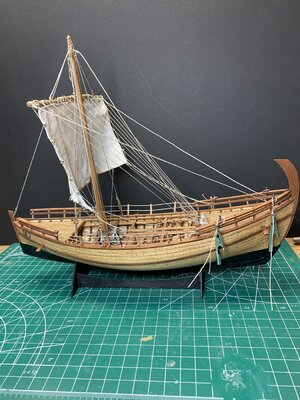
Then looking inside at the mast base for the secured lines and faux hanks:
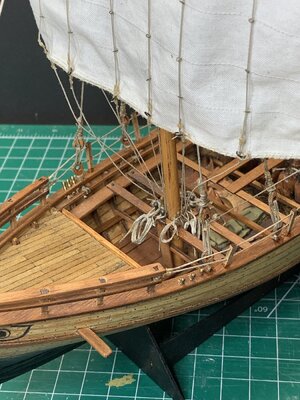
That is fwd port looking aft stbd.
Now another view:
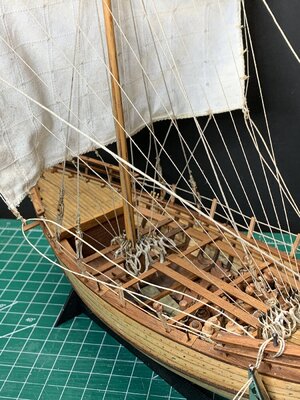
You can see the loose doubled sheet leading to the lower right pin for now.
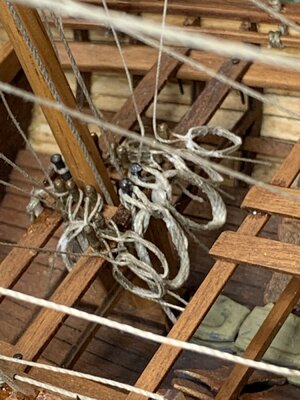
These have a similar messy arrangement as on Kyrenia II but not hanging quite as loosely but still in the casually set manner when last worked.
Now to a forward view from the stern:
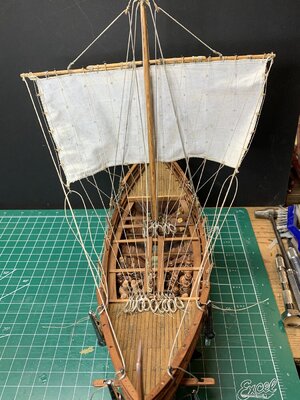
Considering all of those lines I have to seriously wonder how a crew of only four could adjust the lines and the helmsman steering the course????
Now Bow to Stern:
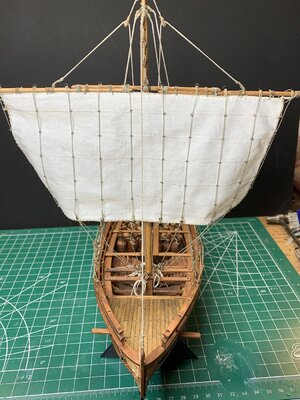
While looking aft and thinking back.. . , the crews had to know what they were doing as brailed sails were around for a few thousand years. It seems that I am getting closer to having to seer to a harbor and get the aft quarter rudders in place along with the anchor for possible stern approach for beaching which was common but usually with several anchors, stone ones in the earliest years. Beaching is still a common practice for small boats in the Mid-East and elsewhere as long as a sandy beach is available. Rich
Good Morning Rich. Every time I look at your boat it is a joy. Your detail and the sail blow me away(excuse the punOut of the dark with arrival of some small belaying pins to go with the faux rope hanks to secure the brail lines forward of the sail. First a Port elevation with those lines secured, the mid-ships safety lines installed, and the yard braces and sail sheets loosely running aft for setting:
View attachment 275158
Then looking inside at the mast base for the secured lines and faux hanks:
View attachment 275159
That is fwd port looking aft stbd.
Now another view:
View attachment 275160
You can see the loose doubled sheet leading to the lower right pin for now.
View attachment 275161
These have a similar messy arrangement as on Kyrenia II but not hanging quite as loosely but still in the casually set manner when last worked.
Now to a forward view from the stern:
View attachment 275162
Considering all of those lines I have to seriously wonder how a crew of only four could adjust the lines and the helmsman steering the course????
Now Bow to Stern:View attachment 275163
While looking aft and thinking back.. . , the crews had to know what they were doing as brailed sails were around for a few thousand years. It seems that I am getting closer to having to seer to a harbor and get the aft quarter rudders in place along with the anchor for possible stern approach for beaching which was common but usually with several anchors, stone ones in the earliest years. Beaching is still a common practice for small boats in the Mid-East and elsewhere as long as a sandy beach is available. Rich
 ) you can be proud of this boat. Love the historical context added into your log as well- ok enough compliments- enjoy.
) you can be proud of this boat. Love the historical context added into your log as well- ok enough compliments- enjoy.Thank you Grant. It has been and remains an enjoyable (in spite of the redo's) few months. RichGood Morning Rich. Every time I look at your boat it is a joy. Your detail and the sail blow me away(excuse the pun) you can be proud of this boat. Love the historical context added into your log as well- ok enough compliments- enjoy.
- Joined
- Sep 3, 2021
- Messages
- 5,177
- Points
- 738

Rich,Out of the dark with arrival of some small belaying pins to go with the faux rope hanks to secure the brail lines forward of the sail. First a Port elevation with those lines secured, the mid-ships safety lines installed, and the yard braces and sail sheets loosely running aft for setting:
View attachment 275158
Then looking inside at the mast base for the secured lines and faux hanks:
View attachment 275159
That is fwd port looking aft stbd.
Now another view:
View attachment 275160
You can see the loose doubled sheet leading to the lower right pin for now.
View attachment 275161
These have a similar messy arrangement as on Kyrenia II but not hanging quite as loosely but still in the casually set manner when last worked.
Now to a forward view from the stern:
View attachment 275162
Considering all of those lines I have to seriously wonder how a crew of only four could adjust the lines and the helmsman steering the course????
Now Bow to Stern:View attachment 275163
While looking aft and thinking back.. . , the crews had to know what they were doing as brailed sails were around for a few thousand years. It seems that I am getting closer to having to seer to a harbor and get the aft quarter rudders in place along with the anchor for possible stern approach for beaching which was common but usually with several anchors, stone ones in the earliest years. Beaching is still a common practice for small boats in the Mid-East and elsewhere as long as a sandy beach is available. Rich
What a beauty to behold! And what a labor of love!
Ignorant as I am, I assumed the running rigging of a single sail vessel to be a walk in the park. Your work definitely renounces my naivety.
Johan
Last edited:
Concertina and Tin Whistle it will be. Thanks, RichCongratulations Rich. You must be so proud of her - you can give yourself a well-deserved pat on the back and pick up the concertina with joy in your heart!
I too knew nothing about this complex rigging of a single square sail but research into ancient history and archaeological reconstruction experiments open new awareness. RichRich,
What a beauty to behold! And what a labor of love!
Ignorant as I am, I assumed the running rigging of a single sail vessel to be a walk in the park. Your work definitely renounces my naivety.
Johan
As I planned I have moved aft to the quarter rudders and tricking the kit up to better match the Kyrenia II reconstruction which was sailed on several experimental voyages.I too knew nothing about this complex rigging of a single square sail but research into ancient history and archaeological reconstruction experiments open new awareness. Rich
First is a photo that Mensis took of this area for my rudder rigging:
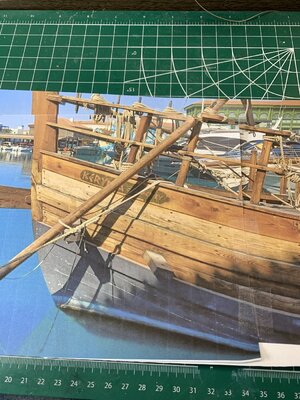
Next is another view aboard of the aft deck area for the helmsman:
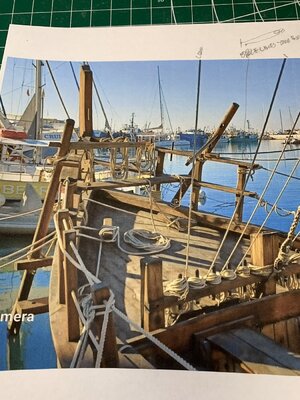
Seeing some added supporting members on top of the rails to secure the rudder pole I added those as well as some additional belaying pins aft which were likely used to secure various lines as needed at different times. I am not sure what lines we can see hanks hanging there so I will leave those out.
Here is my own birds eye view of my deck in preparation for the rudders.
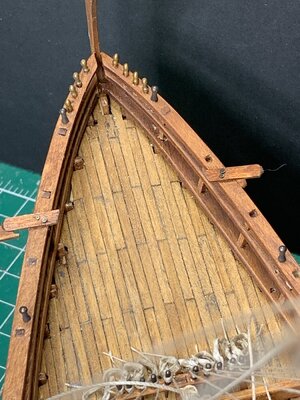
For a test I places one of the rudders with a wrap to be secured to the projecting short
added member.
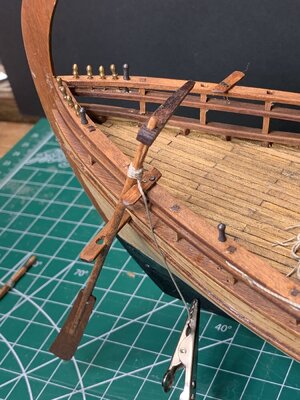
Not shown here I then ran the yard brace to the stantion and pin aft of the rudder for a line check. It passes outboard of the helmsman so all is OK so far. Also not shown is where I spliced the fixed end of the doubled sail sheet which is forward of this and closer to the aft leading brails pin rail. A touch of clear was applied to fold the sheet tightly through the block as there will be no tension on this sail to obtain the same bend as if it were taught. If all looks OK I will next complete mounting and securing the two rudders before completing the sheets and braces. Rich





